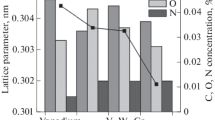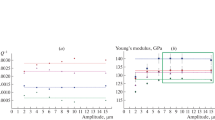Abstract
Interdiffusion coefficients, intrinsic diffusion coefficients, and vacancy wind parameters have been determined in the vanadium-titanium system at 1350°C with the use of infinite, solid-solid diffusion couples. The experimentally determined diffusion coefficients were compared with the values predicted from the models of Darken, Manning and Dayananda with the use of available tracer diffusion and thermodynamic information and were found to be larger than those calculated from the three models. Vacancy wind parameters, determined experimentally, were seen to reflect a greater influence of the vacancy wind phenomenon on the intrinsic diffusion flux of each species than that calculated on the basis of Manning’s theory. In particular, the faster diffusing component is enhanced and the slower diffusing component is retarded to a greater degree than is theoretically predicted. Furthermore, experimental and predicted values of intrinsic diffusivity ratios,D V /D Ti ,were compared and the results suggest an increased effect of vacancy flow on the intrinsic fluxes with respect to the magnitude of this phenomenon calculated from Manning’s treatment. The vacancy wind effect is shown to be an important factor in the consideration of intrinsic diffusion fluxes and their relation to tracer diffusion and thermodynamic information in the vanadium-titanium system.
Similar content being viewed by others
References
Y. Adda and J. Philibert:Compte Rendus, 1958, vol. 247, pp. 80–83.
R. C. Geiss: Air University, U.S. Air Force, MS Thesis, August 1962.
T. C. Reuther, Jr.: U.S. Naval Research Laboratory, NRL Report 6221, December 1964.
C. S. Hartley, J. E. Steedly, Jr., and L. D. Parsons: Air Force Materials Laboratory, Document No. ML-TDR-64-316, December 1964.
R. C. Geiss, C. S. Hartley, and J. E. Steedly, Jr.:J. Less-Common Metals, 1965, vol. 9, pp. 309–20.
P. Lamparter, S. Steels, and A. Gukelberger:High Temperatures-High Pressures, 1971, vol. 3, pp. 727–40.
V. S. Raghunathan, G. P. Tiwari, and B. D. Sharma:Met. Trans., 1972, vol. 3, pp. 783–88.
D. Goold:J. Inst. Metals, 1959-1960, vol. 88, pp. 444–48.
S. G. Fedotov, M. D. Chudinov, and K. M. Konstantinov:Fiz. Metal. Metalloved., 1969, vol. 27, pp. 873–76.
L. S. Darken:Trans. AIME, 1948, vol. 175, pp. 184–201.
J.R. Manning:Acta Met., 1967, vol. 15, pp. 817–26.
J. R. Manning:Met. Trans., 1970, vol. 1, pp. 499–505.
M. A. Dayananda:Met. Trans., 1971, vol. 2, pp. 334–35.
D. J. Schmatz, H. A. Domian, and H. I. Aaronson:J. Appl. Phys., 1966, vol. 37, pp. 1741–43.
A. Kohn, J. Levasseur, J. Philibert, and M. Wanin:Acta Met., 1970, vol. 18, pp. 163–73.
R. O. Meyer:Phys. Rev., 1969, vol. 181, pp. 1086–94.
M. J. Dallwitz:Acta Met., 1972, vol. 20, pp. 1229–34.
N. R. Iorio, M. A. Dayananda, and R. E. Grace:Met. Trans., 1973, vol. 4, pp. 1339–46.
J. F. Murdock and C. J. McHargue:Acta Met., 1968, vol. 16, pp. 493–500.
E. J. Rolinski, M. Hoch, and C. J. Oblinger:Met. Tran., 1971, vol. 2, pp. 2613–18.
M. Hansen:Constitution of Binary Alloys, pp. 1240–42, McGraw-Hill Book Co. New York, 1958.
C. Matano:Japan J. Phys., Trans., 1933, vol. 8, pp. 109–13.
A. D. Smigelskas and E. O. Kirkendall:Trans. AIME, 1947, vol. 171, pp. 130–42.
T. Heumann:Z. Phys. Chem., 1952, vol. 201, pp. 168–69.
H. J. deBruin and R. L. Clark:Rev. Sci. Instrum., 1964, vol. 35, pp. 227–28.
H. R. Ogden and F. C. Holden: Titanium Metallurgical Laboratory, TML Report No. 103, May 1958.
W. J. McG. Tegart:The Electrolytic and Chemical Polishing of Metals in Research and Industry, pp. 50–55, Pergamon Press, London, 1956.
A. G. Guy and A. L. Eiss:Welding Research Supp., November 1957, pp. 473s-80s.
T. O. Ziebold and R. E. Ogilvie:Anal. Chem., 1964, vol. 36, pp. 322–27.
P. T. Carlson: Oak Ridge National Laboratory, ORNL-5045, June 1975.
Author information
Authors and Affiliations
Rights and permissions
About this article
Cite this article
Carlson, P.T. Interdiffusion and intrinsic diffusion in binary vanadium-titanium solid solutions at 1350°C. Metall Trans A 7, 199–208 (1976). https://doi.org/10.1007/BF02644457
Received:
Issue Date:
DOI: https://doi.org/10.1007/BF02644457




